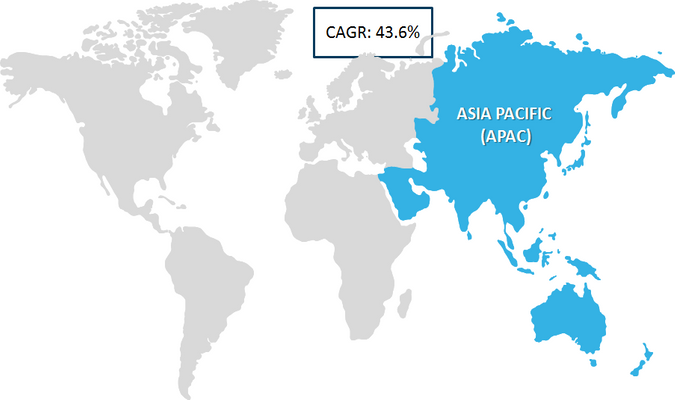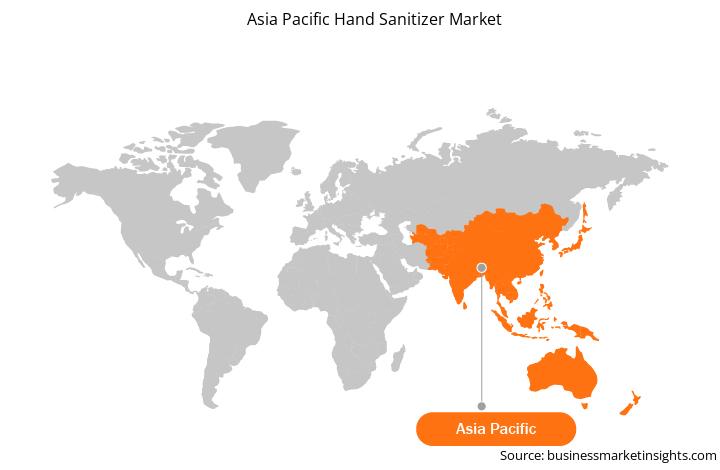The Asia-Pacific hand sanitizer market is accounted to US$ 501.6 Mn in 2018 and is expected to grow at a CAGR of 43.6% during the forecast period 2019 – 2027, to account to US$ 10,198.0 Mn by 2027.
Hand sanitizer is a liquid that is used to decrease infectious agents present on the hands and palm. Different forms of hand sanitizers are available in the market, including foam sanitizers, gel sanitizers, wipes, and spray sanitizers. Both the alcohol-based and non-alcoholic hand sanitizers are offered by most of the market players. These sanitizers kill 99.9% of most common germs and keep the hands clean. Some of the manufacturers are offering foam sanitizers coupled with gel sanitizers that contain vitamin E, and shea extract, which kills most of the common germs & leaves hands feeling soft & clean. The gel-based hand sanitizer coupled with alcohol content kills most common germs that may cause illness. Gel sanitizers have wider applications in hospitals, restaurants, educational institutions, household, shopping malls, movie theatres, and others. Hand sanitizing wipes are also known as antibacterial wipes, which are meant to kill 99 percent of germs, and most of these wipes contain alcohol.

Strategic insights for the Asia Pacific Hand Sanitizer provides data-driven analysis of the industry landscape, including current trends, key players, and regional nuances. These insights offer actionable recommendations, enabling readers to differentiate themselves from competitors by identifying untapped segments or developing unique value propositions. Leveraging data analytics, these insights help industry players anticipate the market shifts, whether investors, manufacturers, or other stakeholders. A future-oriented perspective is essential, helping stakeholders anticipate market shifts and position themselves for long-term success in this dynamic region. Ultimately, effective strategic insights empower readers to make informed decisions that drive profitability and achieve their business objectives within the market.

| Report Attribute | Details |
|---|---|
| Market size in 2018 | US$ 501.6 Million |
| Market Size by 2027 | US$ 10,198.0 Million |
| Global CAGR (2019 - 2027) | 43.6% |
| Historical Data | 2016-2017 |
| Forecast period | 2019-2027 |
| Segments Covered |
By Type
|
| Regions and Countries Covered | Asia-Pacific
|
| Market leaders and key company profiles |
The geographic scope of the Asia Pacific Hand Sanitizer refers to the specific areas in which a business operates and competes. Understanding local distinctions, such as diverse consumer preferences (e.g., demand for specific plug types or battery backup durations), varying economic conditions, and regulatory environments, is crucial for tailoring strategies to specific markets. Businesses can expand their reach by identifying underserved areas or adapting their offerings to meet local demands. A clear market focus allows for more effective resource allocation, targeted marketing campaigns, and better positioning against local competitors, ultimately driving growth in those targeted areas.

Growing awareness among consumers towards maintaining health and hygiene is influencing the market growth of hand sanitizer in this region. The consumers in most of the countries in Asia-Pacificare quite a concern regarding the maintenance of a healthy and hygienic lifestyle. Research study shows that there are so many germs and bacteria spreads that are present in palm & hands and sometimes go to mouth while eating food. Germs can get into the body through the mouth, nose, and breaks in the skin, and eyes. These germs cause various diseases, including skin infection, eye infection, cold, stomach aching, and many others.Frequent uses of hand sanitizers prevent the germs. The government of different countries has also taken initiatives to educate people towards leaving a hygienic lifestyle. Various government and non-government organizations are also actively working to educate people living in remote areas to maintain health and hygiene. These factors are further fueling the market for hand sanitizer.
The Asia-Pacific hand sanitizer market is segmented on the basis of types of hand sanitizeris segmented intoalcoholic, quaternary ammonia, and triclosan. The alcoholic segment is expected to lead the Asia-Pacific hand sanitizer market over the forecast period. Formulations of the alcohol-based hand sanitizers are preferable to hand washing with soap and water in most situations in the healthcare setting. This type of hand sanitizer is generally more effective at killing microorganisms and better tolerated than soap and water. Alcohol-based hand sanitizers typically contain some combination of isopropyl alcohol, ethanol (ethyl alcohol), or n-propanol. Products that contain from 60% to 95% alcohol are most effective. Hand sanitizer with alcohol works against a variety of microorganisms but not spores.The alcohol-based hand sanitizer is on the list of the World Health Organization's Essential Medicines, as the safest and most effective medicines needed to protect health from germs. Alcohol-based hand sanitizer is more convenient as compared to hand washing with soap and water in most situations in the healthcare setting.Alcohol rubbing kills many different kinds of bacteria, including antibiotic-resistant bacteria and TB bacteria. For health care organizations like hospitals and clinics, optimum alcohol concentration to kill bacteria is 70% to 95%. Hand sanitizers with alcohol concentrations as low as 40% are available in American stores, according to researchers at East Tennessee State University.

Strategic insights for the Asia Pacific Hand Sanitizer provides data-driven analysis of the industry landscape, including current trends, key players, and regional nuances. These insights offer actionable recommendations, enabling readers to differentiate themselves from competitors by identifying untapped segments or developing unique value propositions. Leveraging data analytics, these insights help industry players anticipate the market shifts, whether investors, manufacturers, or other stakeholders. A future-oriented perspective is essential, helping stakeholders anticipate market shifts and position themselves for long-term success in this dynamic region. Ultimately, effective strategic insights empower readers to make informed decisions that drive profitability and achieve their business objectives within the market.

| Report Attribute | Details |
|---|---|
| Market size in 2018 | US$ 501.6 Million |
| Market Size by 2027 | US$ 10,198.0 Million |
| Global CAGR (2019 - 2027) | 43.6% |
| Historical Data | 2016-2017 |
| Forecast period | 2019-2027 |
| Segments Covered |
By Type
|
| Regions and Countries Covered | Asia-Pacific
|
| Market leaders and key company profiles |
The geographic scope of the Asia Pacific Hand Sanitizer refers to the specific areas in which a business operates and competes. Understanding local distinctions, such as diverse consumer preferences (e.g., demand for specific plug types or battery backup durations), varying economic conditions, and regulatory environments, is crucial for tailoring strategies to specific markets. Businesses can expand their reach by identifying underserved areas or adapting their offerings to meet local demands. A clear market focus allows for more effective resource allocation, targeted marketing campaigns, and better positioning against local competitors, ultimately driving growth in those targeted areas.

The Asia-Pacific hand sanitizer market is segmented on the basis of product formis segmented into foam sanitizers, gel sanitizers, wipes, spray sanitizers. The gel sanitizer segment is expected to lead the Asia-Pacific hand sanitizer market over the forecast period. The gel-based hand sanitizer, coupled with alcohol content kills most common germs that may cause illness. The product is placed on the hands, and when hands are rubbed together briskly, the alcohol sanitizes and then evaporates. Unlike foam sanitizer, there is no need for water rinse after the use of gel sanitizer. Gel sanitizers have wider application in hospitals, restaurants, educational institutions, household, shopping malls, movie theatres, and others. Since consumers are nowadays become quite aware of maintaining health and hygiene, the gel sanitizer is getting popular. Furthermore, manufacturers are offering this product in a compact size, which is so convenient to carry anywhere. This is further influencing the demand for this product.
The Asia-Pacific hand sanitizer market is segmented on the basis of applicationis segmented into hospitals, restaurants, educational institutions, household, and others. The hospital segment is expected to lead the Asia-Pacific hand sanitizer market over the forecast period.Hand sanitizers are used widely in all hospitals and clinics across the globe, which is driving this market. At hospitals across the world, staffs dutifully slather on hand sanitizer to prevent the spread of infections. The hand sanitizer dosing systems available in hospitals are designed to deliver a measured amount of the gel or liquid sanitizer during each press. There are dosing pumps screwed onto a sanitizer bottle, or are specially designed dispensers are attached with refill bottles. Dispensers used for surgical hand disinfection are usually equipped with elbow controlled mechanism or infrared sensors to avoid any contact with the pump. Alcohol-based hand sanitizers are recommended and widely used in hospitals.
The Asia-Pacific hand sanitizer market is segmented on the basis of distribution channelis segmented into supermarkets & hypermarket, convenience store, online, and others. The supermarkets and hypermarkets segment is expected to lead the Asia-Pacific hand sanitizer market over the forecast period. Hypermarkets and supermarkets are self-help shops giving a wide variety of hand sanitizer products such as foam sanitizers, gel sanitizers, wipes, and spray sanitizers. These wide ranges of products are placed in a very organized way in different sections and shelves to attract customers. These types of stores offer an extensive choice of products to consumers from different brands at one place and affordable prices as compared to other distribution channels. Also, similar products are arranged nearby, which provides buyers with an easy time while comparing different products before purchasing a suitable product. These stores always come with some new types of discount, offer, and brand marketing ways to attract consumers. This factor plays a very major role while buying the hand sanitizer products.
The List of Companies - Asia Pacific Hand Sanitizer Market
The Asia Pacific Hand Sanitizer Market is valued at US$ 501.6 Million in 2018, it is projected to reach US$ 10,198.0 Million by 2027.
As per our report Asia Pacific Hand Sanitizer Market, the market size is valued at US$ 501.6 Million in 2018, projecting it to reach US$ 10,198.0 Million by 2027. This translates to a CAGR of approximately 43.6% during the forecast period.
The Asia Pacific Hand Sanitizer Market report typically cover these key segments-
The historic period, base year, and forecast period can vary slightly depending on the specific market research report. However, for the Asia Pacific Hand Sanitizer Market report:
The Asia Pacific Hand Sanitizer Market is populated by several key players, each contributing to its growth and innovation. Some of the major players include:
The Asia Pacific Hand Sanitizer Market report is valuable for diverse stakeholders, including:
Essentially, anyone involved in or considering involvement in the Asia Pacific Hand Sanitizer Market value chain can benefit from the information contained in a comprehensive market report.